Probability: Theory and Examples
Solutions Manual
The creation of this solution manual was one of the most important im-
provements in the second edition of Probability: Theory and Examples. The
solutions are not intended to be as polished as the proofs in the book, but are
supposed to give enough of the details so that little is left to the reader’s imag-
ination. It is inevitable that some of the many solutions will contain errors. If
you find mistakes or better solutions send them via e-mail to rtd1@cornell.edu
or via post to Rick Durrett, Dept. of Math., 523 Malott Hall, Cornell U., Ithaca
NY 14853.
Rick Durrett
�
Contents
1 Laws of Large Numbers
1
3
7
1
1. Basic Definitions
2. Random Variables
3. Expected Value
4
4. Independence
5. Weak Laws of Large Numbers
6. Borel-Cantelli Lemmas
7. Strong Law of Large Numbers
8. Convergence of Random Series
9. Large Deviations
15
24
12
19
20
2 Central Limit Theorems
26
1. The De Moivre-Laplace Theorem 26
27
2. Weak Convergence
3. Characteristic Functions
4. Central Limit Theorems
6. Poisson Convergence
39
7. Stable Laws
8. Infinitely Divisible Distributions
9. Limit theorems in Rd
31
35
43
45
46
3 Random walks
48
1. Stopping Times
48
4. Renewal theory 51
�
4 Martingales
54
Contents
iii
43
1. Conditional Expectation 54
2. Martingales, Almost Sure Convergence
3. Examples
4. Doob’s Inequality, Lp Convergence
5. Uniform Integrability, Convergence in L1
6. Backwards Martingales
68
7. Optional Stopping Theorems
64
69
57
66
5 Markov Chains
74
74
1. Definitions and Examples
2. Extensions of the Markov Property 75
3. Recurrence and Transience
4. Stationary Measures
5. Asymptotic Behavior
6. General State Space
82
84
88
79
6 Ergodic Theorems
91
91
1. Definitions and Examples
2. Birkhoff’s Ergodic Theorem 93
3. Recurrence
6. A Subadditive Ergodic Theorem 96
7. Applications
95
97
7 Brownian Motion 98
1. Definition and Construction 98
2. Markov Property, Blumenthal’s 0-1 Law 99
3. Stopping Times, Strong Markov Property 100
4. Maxima and Zeros
5. Martingales
102
6. Donsker’s Theorem 105
7. CLT’s for Dependent Variables
8. Empirical Distributions, Brownian Bridge
9. Laws of the Iterated Logarithm 107
101
106
107
�
iv Contents
Appendix: Measure Theory 108
108
1. Lebesgue-Stieltjes Measures
2. Carath´eodary’s Extension Theorem 109
3. Completion, etc.
4. Integration 109
5. Properties of the Integral
6. Product Measures, Fubini’s Theorem 114
8. Radon-Nikodym Theorem 116
109
112
�
1 Laws of Large Numbers
1.1. Basic Definitions
1.1. (i) A and B−A are disjoint with B = A∪(B−A) so P (A)+P (B−A) = P (B)
and rearranging gives the desired result.
(ii) Let A0
m=1A0
Bn are disjoint and have union A we have using (i) and Bm ⊂ Am
n = An ∩ A, B1 = A0
n − ∪n−1
m. Since the
1 and for n > 1, Bn = A0
∞X
P (Bm) ≤
∞X
P (Am)
m=1
m=1
P (A) =
(iii) Let Bn = An − An−1. Then the Bn are disjoint and have ∪∞
∪n
m=1Bm = An so
m=1Bm = A,
∞X
m=1
nX
m=1
P (A) =
P (Bm) = lim
n→∞
P (Bm) = lim
n→∞ P (An)
n ↑ Ac so (iii) implies P (Ac
n) ↑ P (Ac). Since P (Bc) = 1− P (B) it follows
(iv) Ac
that P (An) ↓ P (A).
1.2. (i) Suppose A ∈ Fi for all i. Then since each Fi is a σ-field, Ac ∈ Fi for
each i. Suppose A1, A2, . . . is a countable sequence of disjoint sets that are in
Fi for all i. Then since each Fi is a σ-field, A = ∪mAm ∈ Fi for each i.
(ii) We take the interesection of all the σ-fields containing A. The collection of
all subsets of Ω is a σ-field so the collection is not empty.
1.3. It suffices to show that if F is the σ-field generated by (a1, b1)×···×(an, bn),
then F contains (i) the open sets and (ii) all sets of the form A1 ×··· An where
Ai ∈ R. For (i) note that if G is open and x ∈ G then there is a set of the
form (a1, b1) × ··· × (an, bn) with ai, bi ∈ Q that contains x and lies in G, so
any open set is a countable union of our basic sets. For (ii) fix A2, . . . , An and
�
2 Chapter 1 Laws of Large Numbers
let G = {A : A × A2 × ··· × An ∈ F}. Since F is a σ-field it is easy to see that
if Ω ∈ G then G is a σ-field so if G ⊃ A then G ⊃ σ(A). From the last result it
follows that if A1 ∈ R, A1 × (a2, b2) × ··· × (an, bn) ∈ F. Repeating the last
argument n − 1 more times proves (ii).
1.4. It is clear that if A ∈ F then Ac ∈ F. Now let Ai be a countable collection
i is countable for some i then (∪iAi)c is countable. On the other
of sets. If Ac
hand if Ai is countable for each i then ∪iAi is countable. To check additivity
countable for all j 6= i soPk P (Ak) = 1 = P (∪kAk). On the other hand if Ai
of P now, suppose the Ai are disjoint. If Ac
i is countable for some i then Aj is
is countable for each i then ∪iAi is andPk P (Ak) = 0 = P (∪kAk).
1.5. The sets of the form (a1, b1) × ··· × (ad, bd) where ai, bi ∈ Q is a countable
collection that generates Rd.
1.6. If B ∈ R then {Z ∈ B} = ({X ∈ B} ∩ A) ∪ ({Y ∈ B} ∩ Ac) ∈ F
1.7.
P (χ ≥ 4) ≤ (2π)−1/24−1e
−8 = 3.3345 × 10−5
The lower bound is 15/16’s of the upper bound, i.e., 3.126 × 10−5
1.8. The intervals (F (x−), F (x)), x ∈ R are disjoint and each one that is
nonempty contains a rational number.
1.9. Let ˆF −1(x) = sup{y : F (y) ≤ x} and note that F ( ˆF −1(x)) = x when F is
continuous. This inverse wears a hat since it is different from the one defined
in the proof of (1.2). To prove the result now note that
−1(x)) = F ( ˆF
P (F (X) ≤ x) = P (X ≤ ˆF
−1(x)) = x
1.10. If y ∈ (g(α), g(β)) then P (g(X) ≤ y) = P (X ≤ g−1(y)) = F (g−1(y)).
Differentiating with respect to y gives the desired result.
1.11. If g(x) = ex then g−1(x) = log x and g0(g−1(x)) = x so using the formula
in the previous exercise gives (2π)−1/2e−(log x)2/2/x.
√
1.12. (i) Let F (x) = P (X ≤ x). P (X 2 ≤ y) = F (
Differentiating we see that X 2 has density function
√
y))/2
y) − F (−√
y) + f(−√
y) for y > 0.
√
(f(
y
(ii) In the case of the normal this reduces to (2πy)−1/2e−y/2.
�
Section 1.2 Random Variables 3
1.2. Random Variables
2.1. Let G be the smallest σ-field containing X−1(A). Since σ(X) is a σ-field
containing X−1(A), we must have G ⊂ σ(X) and hence G = {{X ∈ B} : B ∈
F} for some S ⊃ F ⊃ A. However, if G is a σ-field then we can assume F is.
Since A generates S, it follows that F = S.
2.2. If {X1 + X2 < x} then there are rational numbers ri with r1 + r2 < x and
Xi < ri so
{X1 + X2 < x} = ∪r1,r2∈Q:r1+r2 0} = G, so we need
all the open sets to make all the continuous functions measurable.
2.5. If f is l.s.c. and xn is a sequence of points that converge to x and have
f(xn) ≤ a then f(x) ≤ a, i.e., {x : f(x) ≤ a} is closed. To argue the converse
note that if {y : f(y) > a} is open for each a ∈ R and f(x) > a then it is impos-
sible to have a sequence of points xn → x with f(xn) ≤ a so lim inf y→x f(y) ≥ a
and since a < f(x) is arbitrary, f is l.s.c.
The measurability of l.s.c. functions now follows from Example 2.1. For the
other type note that if f is u.s.c. then −f is measurable since it is l.s.c., so
f = −(−f) is.
2.6. In view of the previous exercise we can show f δ is l.s.c. by showing {x :
f δ(x) > a} is open for each a ∈ R. To do this we note that if f δ(x) > a then
there is an � > 0 and a z with |z − x| < δ − � so that f(z) > a but then if
|y− x| < � we have f δ(y) > a. A similar argument shows that {x : fδ(x) < a} is
open for each a ∈ R so fδ is u.s.c. The measurability of f 0 and f0 now follows
from (2.5). The measurability of {f 0 = f0} follows from the fact that f 0 − f0
is.
2.7. Clearly the class of F measurable functions contains the simple functions
and by (2.5) is closed under pointwise limits. To complete the proof now it
suffices to observe that any f ∈ F is the pointwise limit of the simple functions
fn = −n ∨ ([2nf]/2n) ∧ n.
�
4 Chapter 1 Laws of Large Numbers
2.8. Clearly the collection of functions of the form f(X) contains the simple
functions measurable with respect to σ(X). To show that it is closed under
pointwise limits suppose fn(X) → Z, and let f(x) = lim supn fn(x). Since
f(X) = lim supn fn(X) it follows that Z = f(X). Since any f(X) is the
pointwise limit of simple functions, the desired result follows from the previous
exercise.
2.9. Note that for fixed n the Bm,n form a partition of R and Bm,n = B2m,n+1∪
B2m+1,n+1. If we write fn(x) out in binary then as n → ∞ we get more digits
in the expansion but don’t change any of the old ones so limn fn(x) = f(x)
exists. Since |fn(X(ω)) − Y (ω)| ≤ 2−n and fn(X(ω)) → f(X(ω)) for all ω,
Y = f(X).
1.3. Expected Value
3.1. X − Y ≥ 0 so E|X − Y | = E(X − Y ) = EX − EY = 0 and using (3.4) it
follows that P (|X − Y | ≥ �) = 0 for all � > 0.
3.2. (3.1c) is trivial if EX = ∞ or EY = −∞. When EX + < ∞ and EY − < ∞,
we have E|X|, E|Y | < ∞ since EX− ≤ EY − and EX + ≥ EY +.
To prove (3.1a) we can without loss of generality suppose EX−, EY − < ∞
and also that EX + = ∞ (for if E|X|, E|Y | < ∞ the result follows from the
theorem). In this case, E(X + Y )− ≤ EX− + EY − < ∞ and E(X + Y )+ ≥
EX + − EY − = ∞ so E(X + Y ) = ∞ = EX + EY .
To prove (3.1b) we note that it is easy to see that if a 6= 0 E(aX) = aEX. To
complete the proof now it suffices to show that if EY = ∞ then E(Y + b) = ∞,
which is obvious if b ≥ 0 and easy to prove by contradiction if b < 0.
3.3. Recall the proof of (5.2) in the Appendix. We let `(x) ≤ ϕ(x) be a linear
function with `(EX) = ϕ(EX) and note that Eϕ(X) ≥ E`(X) = `(EX). If
equality holds then Exercise 3.1 implies that ϕ(X) = `(X) a.s. When ϕ is
strictly convex we have ϕ(x) > `(x) for x 6= EX so we must have X = EX a.s.
3.4. There is a linear function
ψ(x) = ϕ(EX1, . . . , EXn) +
ai(xi − EXi)
nX
so that ϕ(x) ≥ ψ(x) for all x. Taking expected values now and using (3.1c)
now gives the desired result.
3.5. (i) Let P (X = a) = P (X = −a) = b2/2a2, P (X = 0) = 1 − (b2/a2).
i=1
�
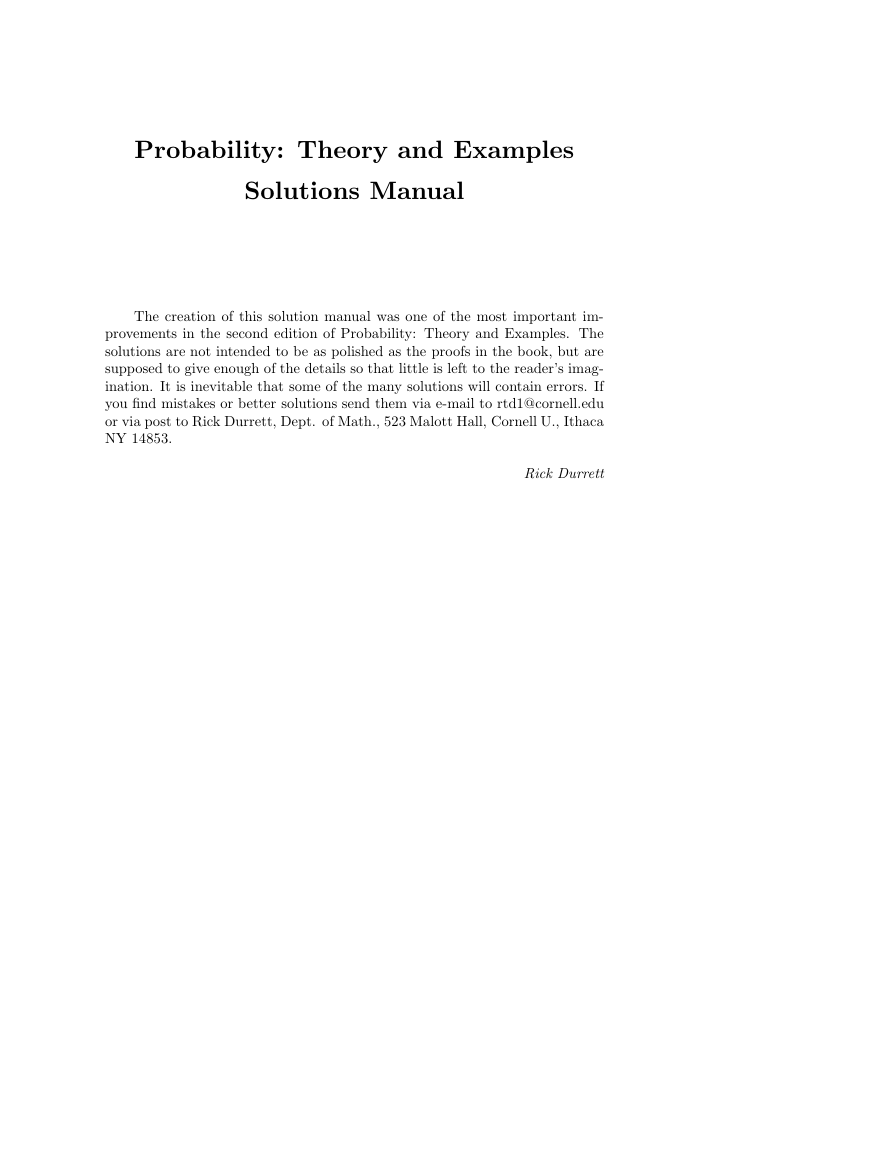
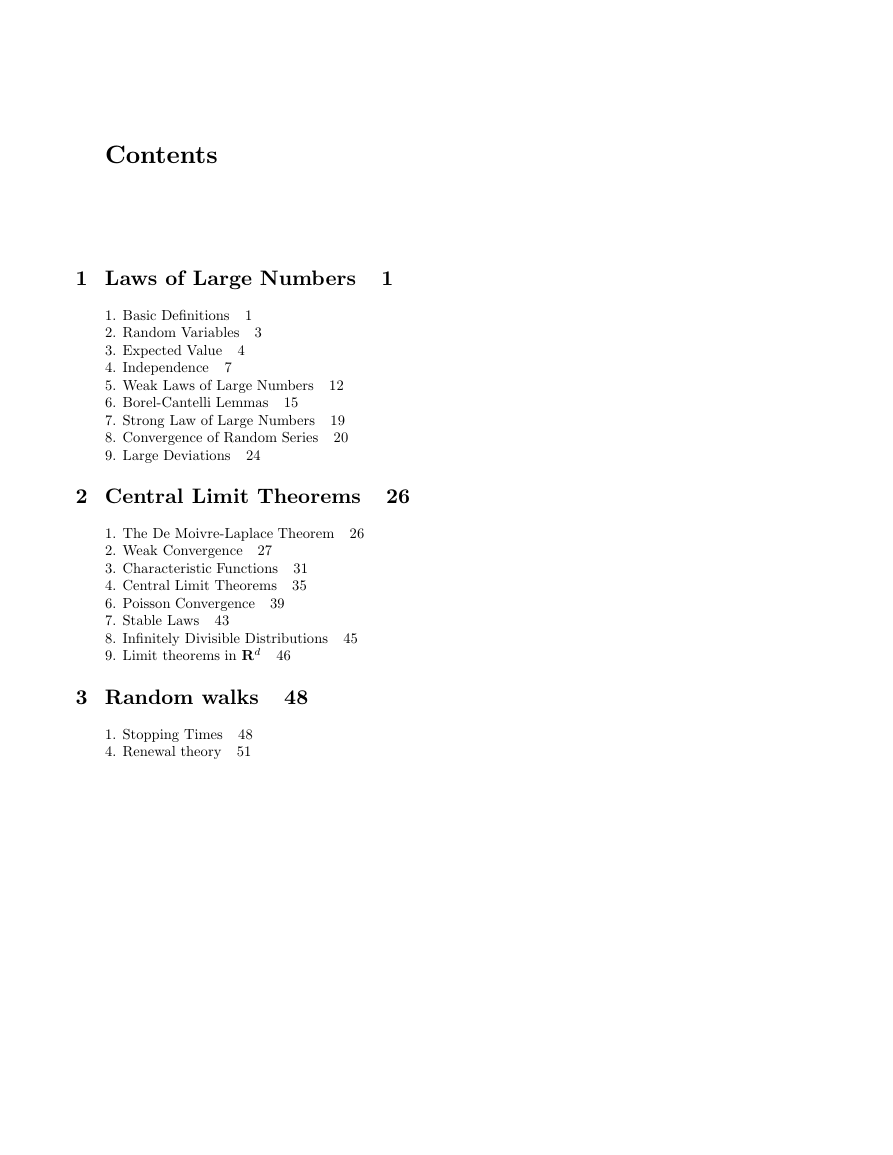
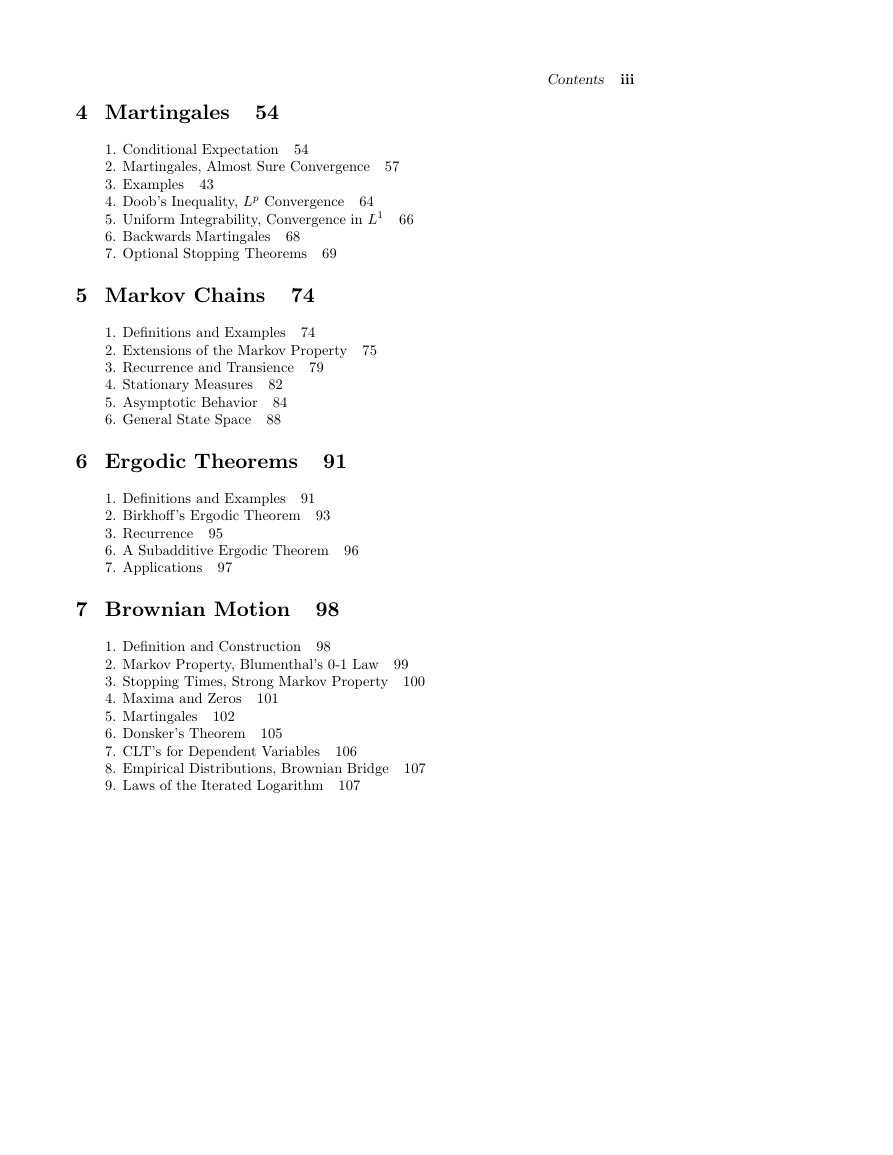
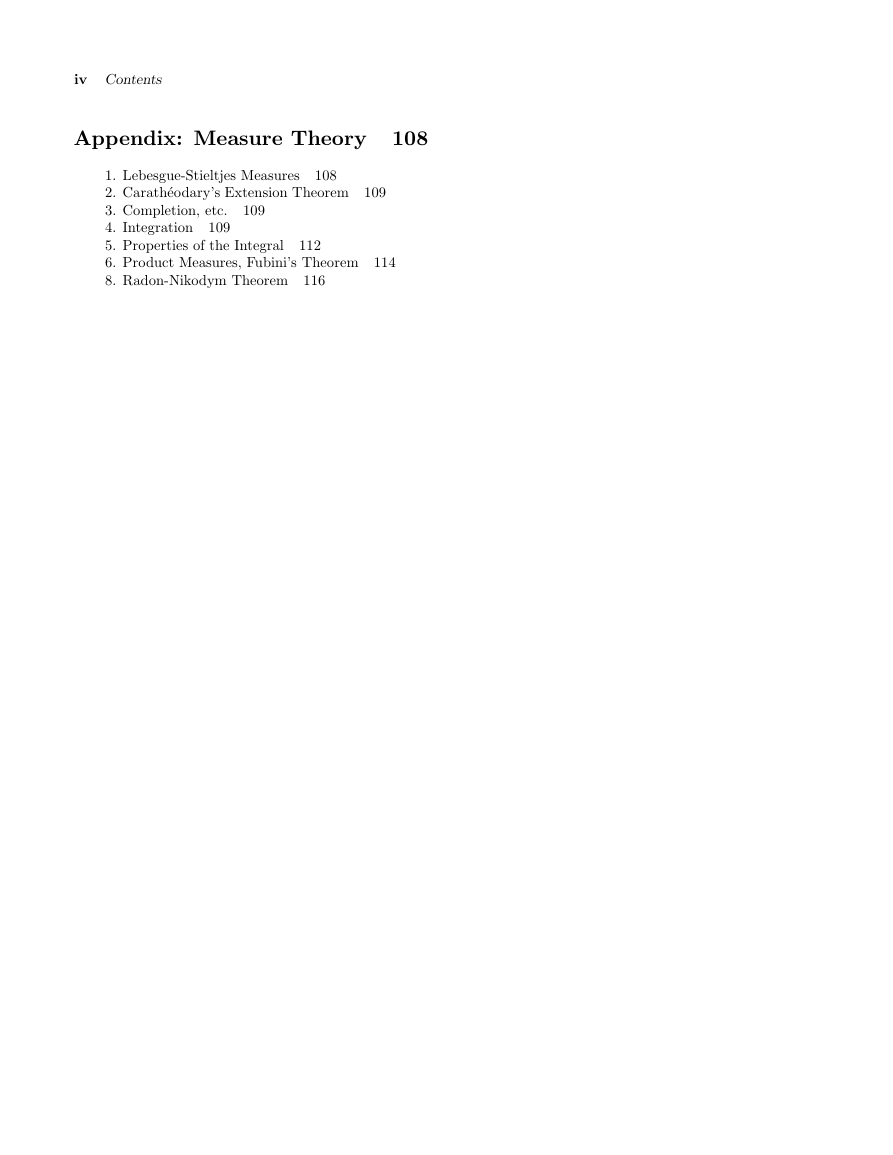
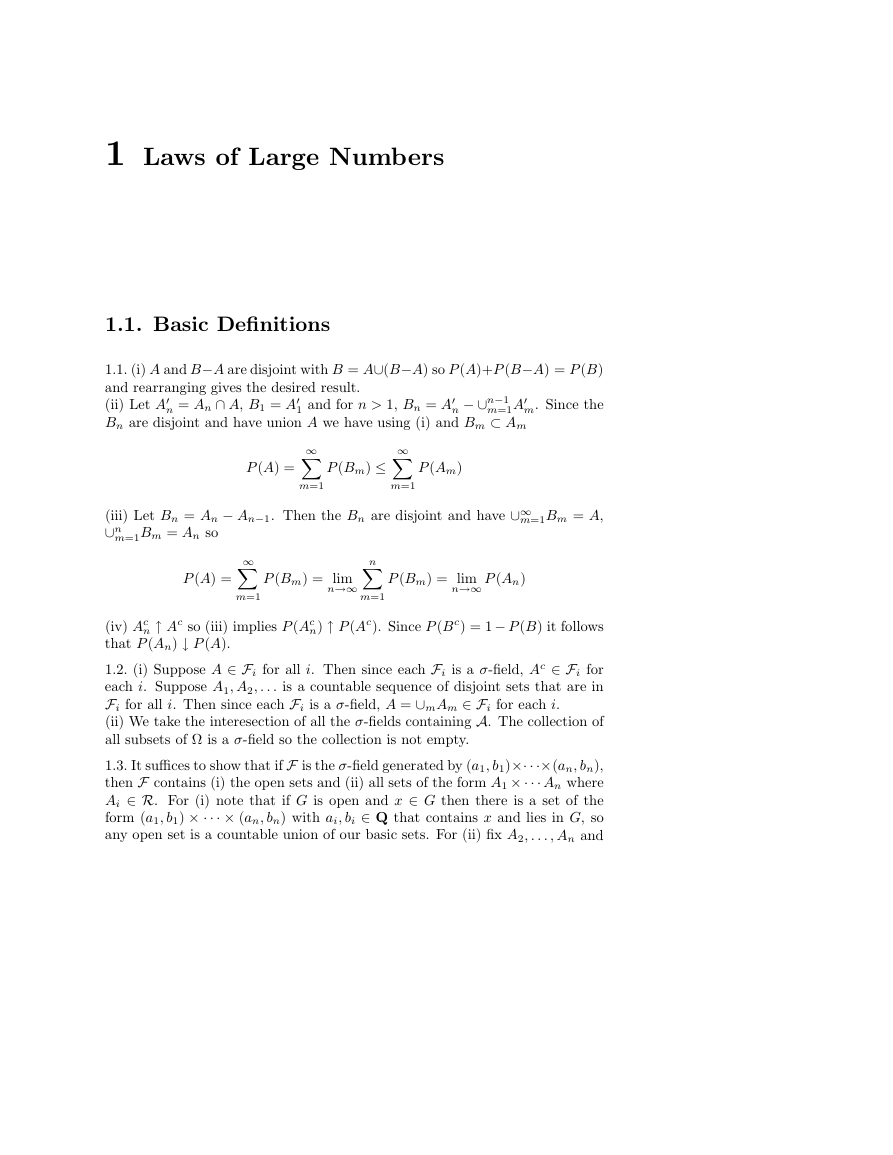
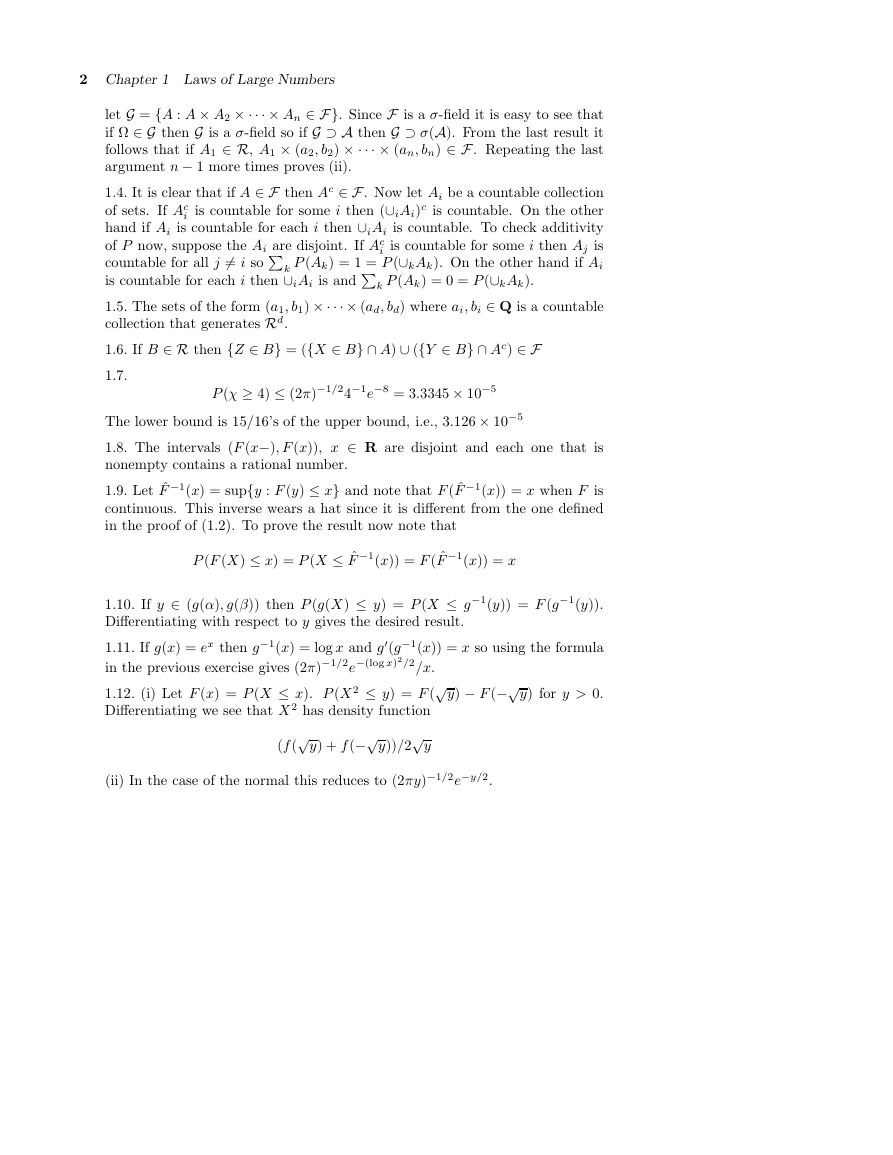

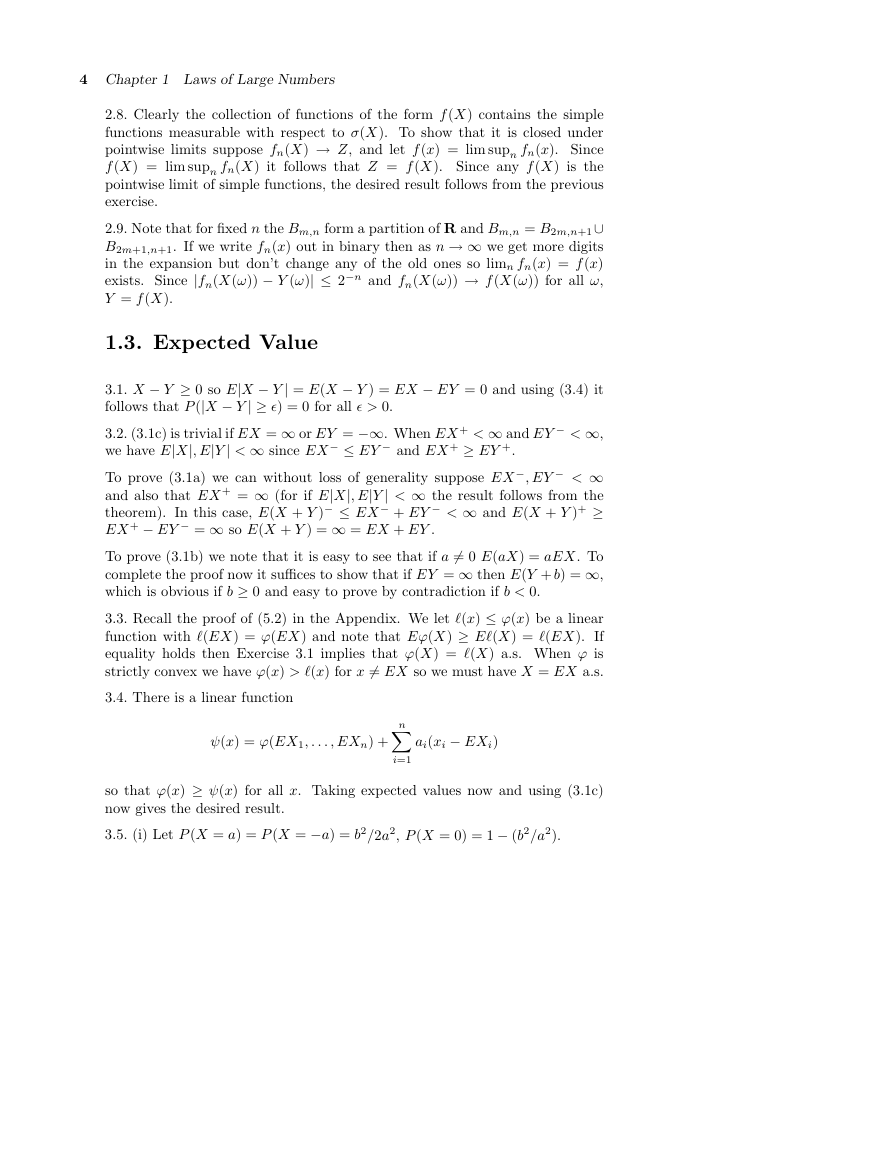








 2023年江西萍乡中考道德与法治真题及答案.doc
2023年江西萍乡中考道德与法治真题及答案.doc 2012年重庆南川中考生物真题及答案.doc
2012年重庆南川中考生物真题及答案.doc 2013年江西师范大学地理学综合及文艺理论基础考研真题.doc
2013年江西师范大学地理学综合及文艺理论基础考研真题.doc 2020年四川甘孜小升初语文真题及答案I卷.doc
2020年四川甘孜小升初语文真题及答案I卷.doc 2020年注册岩土工程师专业基础考试真题及答案.doc
2020年注册岩土工程师专业基础考试真题及答案.doc 2023-2024学年福建省厦门市九年级上学期数学月考试题及答案.doc
2023-2024学年福建省厦门市九年级上学期数学月考试题及答案.doc 2021-2022学年辽宁省沈阳市大东区九年级上学期语文期末试题及答案.doc
2021-2022学年辽宁省沈阳市大东区九年级上学期语文期末试题及答案.doc 2022-2023学年北京东城区初三第一学期物理期末试卷及答案.doc
2022-2023学年北京东城区初三第一学期物理期末试卷及答案.doc 2018上半年江西教师资格初中地理学科知识与教学能力真题及答案.doc
2018上半年江西教师资格初中地理学科知识与教学能力真题及答案.doc 2012年河北国家公务员申论考试真题及答案-省级.doc
2012年河北国家公务员申论考试真题及答案-省级.doc 2020-2021学年江苏省扬州市江都区邵樊片九年级上学期数学第一次质量检测试题及答案.doc
2020-2021学年江苏省扬州市江都区邵樊片九年级上学期数学第一次质量检测试题及答案.doc 2022下半年黑龙江教师资格证中学综合素质真题及答案.doc
2022下半年黑龙江教师资格证中学综合素质真题及答案.doc